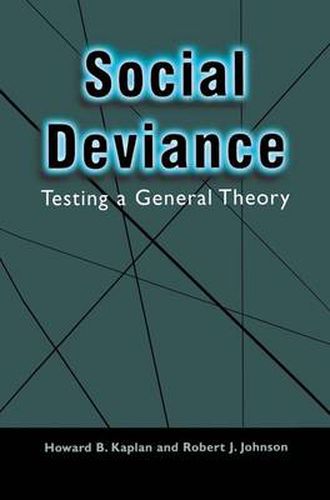Readings Newsletter
Become a Readings Member to make your shopping experience even easier.
Sign in or sign up for free!
You’re not far away from qualifying for FREE standard shipping within Australia
You’ve qualified for FREE standard shipping within Australia
The cart is loading…






This title is printed to order. This book may have been self-published. If so, we cannot guarantee the quality of the content. In the main most books will have gone through the editing process however some may not. We therefore suggest that you be aware of this before ordering this book. If in doubt check either the author or publisher’s details as we are unable to accept any returns unless they are faulty. Please contact us if you have any questions.
Inthisvolumewereportaseriesofanalysesofpaneldatadesignedtotestaspects ofacomprehensivetheoreticalstatementaboutthesocialandsocial-psychological processesthatplayapartintheonsetandcourse(includingcessationandcontinu- ationatincreased,decreased,orconstantlevels)ofdeviantbehavior. InPartIwe outlineourtheoreticalandmethodologicalapproachtothestudyofdeviantbehav- ior. ChapterIpresentsacomprehensivetheoreticalstatementthathasevolvedover aperiodofmorethantwodecades(Kaplan,1972,1975b,1980,1982,1983,1984, 1986,1995,1996)outofaconsiderationofthetheoreticalandempiricalreports ofothersandinresponsetoourownearliertestsofthegeneraltheory(Kaplan & Damphousse,1997;Kaplan&Fukurai,1992;Kaplan&Johnson,1991;Kaplan, Johnson, &Bailey,1986,1987,1988;Kaplan,Martin, &Johnson,1986;Kaplan & Peck,1992). Thestatementisorganizedasaresponsetofourinterrelatedquestions: Whatsocialandsocial-psychologicalfactors(1)influencethesocialdefinitionof deviantbehavior;(2)motivateindividualstoperformdeviantbehaviors;(3)facili- tatetheperformanceofdeviantbehaviorindependentlyoforininteractionwithfac- torsthatinfluencemotivationtoengageindeviantbehavior;and(4)influencethe stabilityofdeviantbehavior,independentlyoforininteractionwithfactorsthat influencetheinitiationofdeviantbehavior?Thisstatementprovidesaframework andrationaleforthemultivariatemodelsweestimateandreportinlaterpartsofthe volume. Chapter2providesdetailsofthepaneldesignandmultivariateanalytic techniques. Thesample,arandomhalfofthe1971cohortofseventhgradersina largeurbanschooldistrict,wastesteduptofourtimesbetweenearlyadolescence andyoungadulthood. Thetheoreticallyinformedmultivariatemodelsaretested usingtheLISRELVIprogram(Joreskog &Sorbom,1986)toestimatethestruc- turalrelationshipsamonglatentvariables. InPartIIweestimateseveralmodelsthataccountforvariationindeviant behaviormeasuredintheninthgradeintermsofconstructsmeasuredinthesev- enthandeighthgrades. InChapter3weestimate,forallsubjectswhoprovideddata duringtheseventh,eighth,andninthgradetestings,aseriesoffourincreasingly elaboratedmodelsinwhichanewvariableisaddedtotheimmediatelypreceding modelasplayingcommonantecedentand/orinterveningexplanatoryroles. The vii viii Preface mostinclusivemodelhasbeenpublishedpreviouslyinitspresentform(Kaplan & Johnson,1991);thethreelessinclusivemodelshaveappearedinsomewhatdiffer- entform(Johnson &Kaplan,1987;Kaplan,Johnson, &Bailey,1986,1987;Kaplan, Martin, &Johnson,1986). Thepresentversionsdifferfromtheearlierversionsin termsofexogenousvariables,measurementvariables,samplesize,andinclusionof correlateddisturbancesinthemodels. Therepetitionofthemostinclusivemodel andthereestimationoftheotherthreemodelspermitustodescribeandeasilycom- municatetheeffectsofeachsuccessivetheoreticalelaborationandtodiscussthe resultsingreaterdetailthanpublicationintheperiodicalliteraturegenerallyper- mits. Thereproductionofthemostinclusivemodelalsoprovidesabaseagainst whichwecancomparethemodelsestimatedinthenexttwochapters. InChapters 4and5,respectively,weestimatethismodelforsubgroupsinordertotestassump- tionsabouttheequivalenceofmeasurementmodelsandstructuralinvariance betweenthedifferentsocialgroupings. InChapter4weestimatethemodelfor malesandfemales. InChapter5weestimatethemostinclusiveexplanatorymodel forsubgroupsdifferentiatedaccordingtorace/ethnicity. InPartIIIwereportanalysesthataddressthevalidityofthemodelasan explanationofdeviantbehaviorthatismeasuredandexpressedinyoungadult- hood. InChapter6theelaboratedmodelasanexplanationofdeviantbehaviorin youngadulthoodisestimatedforthemostinclusivegroupingavailable,white malesandfemalesconsideredtogether. Whenwewereattemptingtoconductsub- groupanalysisforgroupsdifferentiatedaccordingtorace/ethnicity,itbecame apparentthat-unlikethesituationinpredictingdeviantbehaviorinearlyadoles- cence-themeasuresofdeviantbehaviorusedfortheyoungadultanalyses formedavalidconstructonlyforthewhitesubjects. Themeasuresoftheconstruct werenotsufficientlyvalidorreliabletopermitestimationinasampleofyoung blackadults. Further,forHispanicsubjectsthesamplesizesimplywastoosmall toprovidestableestimatesrelativetothenumberofparametersinthemostcom- prehensivemodel. Hence,inordertoconsiderthedifferentialexplanatorypower oftheelaboratedmodelinaccountingfordeviantbehaviorinyoungadulthood andearlyadolescence,respectively,weusedthemodelsforwhitesubjectsas pointsofreference. InChapter7weapplytheelaboratedmodeltotheexplana- tionofdevianceinyoungadulthoodformalesandfemalesconsideredseparately. InPartIVwesummarizetheanalysesandofferconclusionsaboutthe significanceofthiswork. Chapter8considerstheusefulnessofthecomprehen- sivetheoryinexplainingsomeofthevarianceindeviantbehavioratdifferent pointsinthelifecycleandspecifyingthenatureoftherelationshipsamong explanatoryvariables. Inclosing,weofferillustrativesubsequentstudiesthat buildontheearliertheoryandanalyticstrategies. Acknowledgments ThisworkwassupportedinpartbyresearchgrantsROIDA02497andROI DA04310andbyaResearchScientistAward(K05DAOOI36)tothefIrst-named author,allfromtheNationalInstituteonDrugAbuse. Wearepleasedtorecognizetheunwaveringdedicationof Sam McLean, HollyGroves,andJeffersonRogerstothetechnicalproductionofthemanuscript. Wherewerecognizetheoriginsofourideas,weacknowledgethesesources byappropriatetextualcitations. However,manyofourideas-particularlyas thesearesynthesizedinourcomprehensivetheoryofdeviantbehavior-arethe productsoflifetimesofscholarlyactivityandtheprecisesourcesororiginalityof theseideascannolongerbedetermined. Thus,oftenwemustleaveittoothersto makejudgmentsaboutthehistoricalroots,originality,orindependentcreationof thetheoreticalstatementsinthisvolume. ix Contents PART I. THEORETICAL AND METHODOLOGICAL APPROACHES TO THE STUDY OF DEVIANT BEHAVIOR 1. Toward a General Theory of Deviant Behavior 3 TheNatureofDeviance…3 MotivationtoCommitDeviantActsthatViolateMembership GroupNorms…6 MotivationtoCommitDeviantActsthatConformtoMembershipGroup Norms…9 ActingOutDeviantDispositions 10 ContinuityofDeviantBehavior…17 2. Method…25 SampleandDataCollection…25 Analysis…26 MeasurementModel 26 StructuralModel 30 SubgroupComparisons 36 PART II. DEVIANT BEHAVIOR IN ADOLESCENCE 3. An Elaboration Strategy for the Study of Deviant Behavior 41 ModelI:Self-Rejection intheExplanationofDeviance…43 ModelII:ContinuityofEarlyDeviance…47 Methods…53 xi xii Contents Results…58 DiscussionofModelsIandII 63 ModelIII:DeviantPeerAssociationsandDeviantBehavior 66 Theory…67 Methods…7 3 Results…75 DiscussionofModelIII…79 Conclusion…86 ModelIV:NegativeSocialSanctionsfromtheLabelingPerspective 87 EmpiricalSupport 88 TheoreticalIssues 89 ElaboratingaModelofDeviantBehavior 96 Method 100 Results…103 DiscussionofModelIV…108 Appendix…119 4. GenderasaModeratorinExplanationsofAdolescentDeviance*.
$9.00 standard shipping within Australia
FREE standard shipping within Australia for orders over $100.00
Express & International shipping calculated at checkout
This title is printed to order. This book may have been self-published. If so, we cannot guarantee the quality of the content. In the main most books will have gone through the editing process however some may not. We therefore suggest that you be aware of this before ordering this book. If in doubt check either the author or publisher’s details as we are unable to accept any returns unless they are faulty. Please contact us if you have any questions.
Inthisvolumewereportaseriesofanalysesofpaneldatadesignedtotestaspects ofacomprehensivetheoreticalstatementaboutthesocialandsocial-psychological processesthatplayapartintheonsetandcourse(includingcessationandcontinu- ationatincreased,decreased,orconstantlevels)ofdeviantbehavior. InPartIwe outlineourtheoreticalandmethodologicalapproachtothestudyofdeviantbehav- ior. ChapterIpresentsacomprehensivetheoreticalstatementthathasevolvedover aperiodofmorethantwodecades(Kaplan,1972,1975b,1980,1982,1983,1984, 1986,1995,1996)outofaconsiderationofthetheoreticalandempiricalreports ofothersandinresponsetoourownearliertestsofthegeneraltheory(Kaplan & Damphousse,1997;Kaplan&Fukurai,1992;Kaplan&Johnson,1991;Kaplan, Johnson, &Bailey,1986,1987,1988;Kaplan,Martin, &Johnson,1986;Kaplan & Peck,1992). Thestatementisorganizedasaresponsetofourinterrelatedquestions: Whatsocialandsocial-psychologicalfactors(1)influencethesocialdefinitionof deviantbehavior;(2)motivateindividualstoperformdeviantbehaviors;(3)facili- tatetheperformanceofdeviantbehaviorindependentlyoforininteractionwithfac- torsthatinfluencemotivationtoengageindeviantbehavior;and(4)influencethe stabilityofdeviantbehavior,independentlyoforininteractionwithfactorsthat influencetheinitiationofdeviantbehavior?Thisstatementprovidesaframework andrationaleforthemultivariatemodelsweestimateandreportinlaterpartsofthe volume. Chapter2providesdetailsofthepaneldesignandmultivariateanalytic techniques. Thesample,arandomhalfofthe1971cohortofseventhgradersina largeurbanschooldistrict,wastesteduptofourtimesbetweenearlyadolescence andyoungadulthood. Thetheoreticallyinformedmultivariatemodelsaretested usingtheLISRELVIprogram(Joreskog &Sorbom,1986)toestimatethestruc- turalrelationshipsamonglatentvariables. InPartIIweestimateseveralmodelsthataccountforvariationindeviant behaviormeasuredintheninthgradeintermsofconstructsmeasuredinthesev- enthandeighthgrades. InChapter3weestimate,forallsubjectswhoprovideddata duringtheseventh,eighth,andninthgradetestings,aseriesoffourincreasingly elaboratedmodelsinwhichanewvariableisaddedtotheimmediatelypreceding modelasplayingcommonantecedentand/orinterveningexplanatoryroles. The vii viii Preface mostinclusivemodelhasbeenpublishedpreviouslyinitspresentform(Kaplan & Johnson,1991);thethreelessinclusivemodelshaveappearedinsomewhatdiffer- entform(Johnson &Kaplan,1987;Kaplan,Johnson, &Bailey,1986,1987;Kaplan, Martin, &Johnson,1986). Thepresentversionsdifferfromtheearlierversionsin termsofexogenousvariables,measurementvariables,samplesize,andinclusionof correlateddisturbancesinthemodels. Therepetitionofthemostinclusivemodel andthereestimationoftheotherthreemodelspermitustodescribeandeasilycom- municatetheeffectsofeachsuccessivetheoreticalelaborationandtodiscussthe resultsingreaterdetailthanpublicationintheperiodicalliteraturegenerallyper- mits. Thereproductionofthemostinclusivemodelalsoprovidesabaseagainst whichwecancomparethemodelsestimatedinthenexttwochapters. InChapters 4and5,respectively,weestimatethismodelforsubgroupsinordertotestassump- tionsabouttheequivalenceofmeasurementmodelsandstructuralinvariance betweenthedifferentsocialgroupings. InChapter4weestimatethemodelfor malesandfemales. InChapter5weestimatethemostinclusiveexplanatorymodel forsubgroupsdifferentiatedaccordingtorace/ethnicity. InPartIIIwereportanalysesthataddressthevalidityofthemodelasan explanationofdeviantbehaviorthatismeasuredandexpressedinyoungadult- hood. InChapter6theelaboratedmodelasanexplanationofdeviantbehaviorin youngadulthoodisestimatedforthemostinclusivegroupingavailable,white malesandfemalesconsideredtogether. Whenwewereattemptingtoconductsub- groupanalysisforgroupsdifferentiatedaccordingtorace/ethnicity,itbecame apparentthat-unlikethesituationinpredictingdeviantbehaviorinearlyadoles- cence-themeasuresofdeviantbehaviorusedfortheyoungadultanalyses formedavalidconstructonlyforthewhitesubjects. Themeasuresoftheconstruct werenotsufficientlyvalidorreliabletopermitestimationinasampleofyoung blackadults. Further,forHispanicsubjectsthesamplesizesimplywastoosmall toprovidestableestimatesrelativetothenumberofparametersinthemostcom- prehensivemodel. Hence,inordertoconsiderthedifferentialexplanatorypower oftheelaboratedmodelinaccountingfordeviantbehaviorinyoungadulthood andearlyadolescence,respectively,weusedthemodelsforwhitesubjectsas pointsofreference. InChapter7weapplytheelaboratedmodeltotheexplana- tionofdevianceinyoungadulthoodformalesandfemalesconsideredseparately. InPartIVwesummarizetheanalysesandofferconclusionsaboutthe significanceofthiswork. Chapter8considerstheusefulnessofthecomprehen- sivetheoryinexplainingsomeofthevarianceindeviantbehavioratdifferent pointsinthelifecycleandspecifyingthenatureoftherelationshipsamong explanatoryvariables. Inclosing,weofferillustrativesubsequentstudiesthat buildontheearliertheoryandanalyticstrategies. Acknowledgments ThisworkwassupportedinpartbyresearchgrantsROIDA02497andROI DA04310andbyaResearchScientistAward(K05DAOOI36)tothefIrst-named author,allfromtheNationalInstituteonDrugAbuse. Wearepleasedtorecognizetheunwaveringdedicationof Sam McLean, HollyGroves,andJeffersonRogerstothetechnicalproductionofthemanuscript. Wherewerecognizetheoriginsofourideas,weacknowledgethesesources byappropriatetextualcitations. However,manyofourideas-particularlyas thesearesynthesizedinourcomprehensivetheoryofdeviantbehavior-arethe productsoflifetimesofscholarlyactivityandtheprecisesourcesororiginalityof theseideascannolongerbedetermined. Thus,oftenwemustleaveittoothersto makejudgmentsaboutthehistoricalroots,originality,orindependentcreationof thetheoreticalstatementsinthisvolume. ix Contents PART I. THEORETICAL AND METHODOLOGICAL APPROACHES TO THE STUDY OF DEVIANT BEHAVIOR 1. Toward a General Theory of Deviant Behavior 3 TheNatureofDeviance…3 MotivationtoCommitDeviantActsthatViolateMembership GroupNorms…6 MotivationtoCommitDeviantActsthatConformtoMembershipGroup Norms…9 ActingOutDeviantDispositions 10 ContinuityofDeviantBehavior…17 2. Method…25 SampleandDataCollection…25 Analysis…26 MeasurementModel 26 StructuralModel 30 SubgroupComparisons 36 PART II. DEVIANT BEHAVIOR IN ADOLESCENCE 3. An Elaboration Strategy for the Study of Deviant Behavior 41 ModelI:Self-Rejection intheExplanationofDeviance…43 ModelII:ContinuityofEarlyDeviance…47 Methods…53 xi xii Contents Results…58 DiscussionofModelsIandII 63 ModelIII:DeviantPeerAssociationsandDeviantBehavior 66 Theory…67 Methods…7 3 Results…75 DiscussionofModelIII…79 Conclusion…86 ModelIV:NegativeSocialSanctionsfromtheLabelingPerspective 87 EmpiricalSupport 88 TheoreticalIssues 89 ElaboratingaModelofDeviantBehavior 96 Method 100 Results…103 DiscussionofModelIV…108 Appendix…119 4. GenderasaModeratorinExplanationsofAdolescentDeviance*.